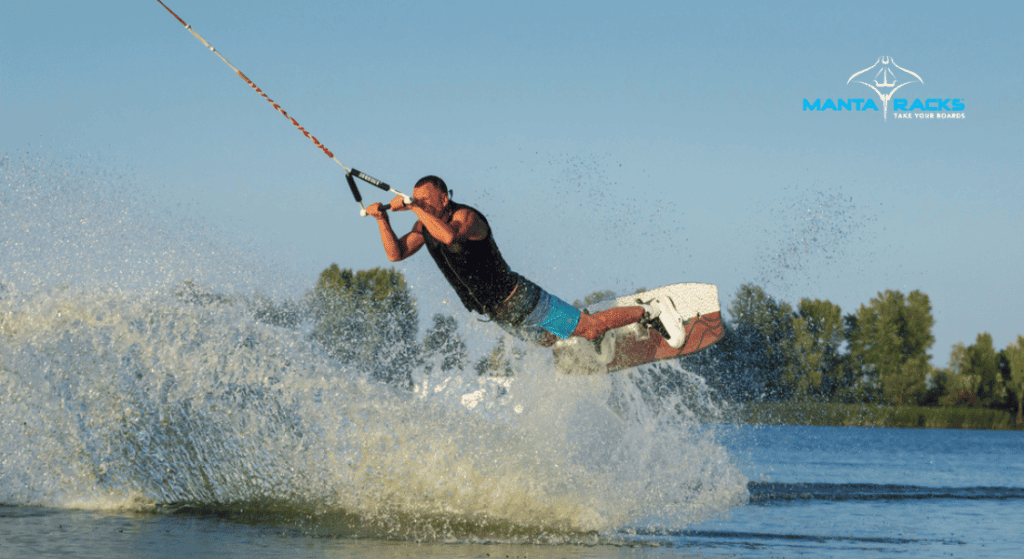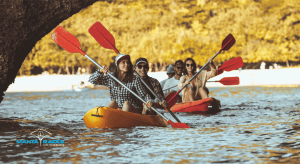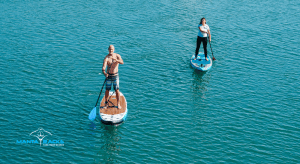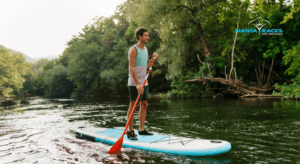Are you new to wakeboarding or seeking to enhance your existing skills? This guide provides clear and concise wakeboarding tips, tailored for beginners. We’ll zero in on vital techniques, safety tips, and top gear picks, all aimed at boosting your performance on the waves. Our goal is to smooth out the learning curve, enabling you to quickly gain confidence and skill on the water and establish a strong footing in the sport. So, stay with us as we dive deeper into the sport and share some of our wakeboarding tips and tricks.
Essential Gear for Wakeboarding Success
When it comes to wakeboarding, the right gear can enhance your experience big time. From safety measures to performance advantages, having the proper equipment is a smart idea for any sport, especially wakeboarding.
There are a few essential pieces of gear that every wakeboarder should have: of course a wakeboard, wakeboard-specific rope and handle, a properly fitted life jacket, and a reliable helmet. And if you want to keep your deck free of boards, consider adding Manta Racks B2 Wakeboard & Waterski Storage Rack to your boat. Our sturdy rack makes transporting and storing your wakeboard on a boat much easier. It easily fits into your existing fishing rod holders, protecting your wakeboard without taking up valuable deck space. Its user-friendly design and space-saving benefits make it an excellent addition to your wakeboarding gear.

Wakeboard
Last but certainly not least, you’ll need a wakeboard. Wakeboards come in various shapes and sizes, each designed for a different style of riding and skill level. For beginners, a longer board is recommended as it offers more stability and easier control. As you progress, you might choose to switch to a shorter board for more maneuverability.
When choosing a wakeboard, consider your weight, riding style, and skill level. Look for a board with an appropriate level of rocker (the curve of the board from tip to tail), flex, and base features (like channels and fins) to suit your needs.
Remember, the right gear can make a significant difference in your wakeboarding experience. So, choose wisely and have fun out there on the water!
Wakeboarding Rope
The wakeboarding rope is key to your success. Unlike the ropes used for water skiing, wakeboarding ropes are non-stretch to provide a more direct connection with the boat. They’re typically between 55 and 75 feet long, depending on the boat’s wake and the rider’s skill level. The rope should be strong, durable, and easy to grip, even when wet.
Wakeboarding Handle
The handle is attached to the end of the rope and is what you’ll hold onto while riding. It needs to be comfortable to grip and should be wide enough to allow for tricks and maneuvers. The handle should be made of a material that doesn’t slip when wet, and it should be durable enough to withstand the high-speed pulls and tugs that come with wakeboarding.
Life Jacket
When it comes to wakeboarding, a life jacket is a must-have. It’s not just a lifesaver, it also boosts your confidence in the water. Make sure it’s Coast Guard-approved and fits you well. Life jackets help you float if you fall, keeping you safe and sound.
Having a spotter on the boat is also crucial. They can alert the driver if you fall and watch out for hazards. Always prioritize safety when wakeboarding. No trick or speed is worth risking your health.
Helmet
Wearing a helmet while wakeboarding, although not mandatory, can offer significant protection, especially for beginners. A good wakeboarding helmet should have features like ear coverage and impact-absorbing material to prevent serious injuries. When choosing a helmet, look for a soft foam lining, stainless steel hardware, and a sturdy outer shell. It should fit snugly but comfortably, with a chin strap that keeps it secure. This precaution can boost confidence for riders of all levels.
Manta Racks Wakeboard Rack
A sometimes overlooked, but essential piece of wakeboarding equipment – a wakeboard rack. Specifically, Manta Racks’ B2 wakeboard rack.
Installing our wakeboard rack is a cinch, requiring only four screws for assembly. It’s designed to fit seamlessly on fishing boats with existing rod holders. Once installed, your wakeboards are safely stowed away, clearing valuable deck space for other activities. The secure design ensures your boards stay put, even in choppy waters, allowing you to focus on perfecting your ride without worrying about your gear.
Mastering the Fundamentals: Key Techniques for Beginners
Once you have organized your gear, it’s important to focus on the essentials. For beginners, having a strong grasp of the basics is crucial. These include standing up on the board, maintaining balance, and improving turning and edging skills. Mastering these fundamental techniques will boost your confidence in wakeboarding and pave the way for you to progress to more advanced maneuvers.
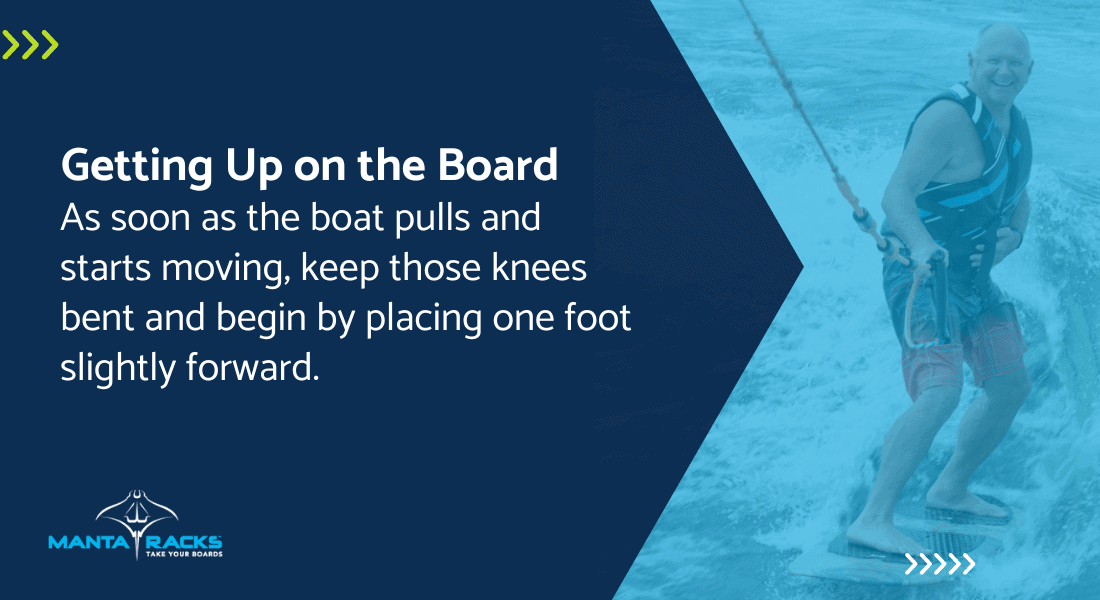
In the following sections, we will delve deeper into each of these key techniques with helpful tips for beginners.
Getting Up on the Board
The process of getting up on a wakeboard for the first time can be daunting, but it’s important to stay patient and make sure your rope is properly set up. Make sure the rope goes through the center of your board before starting to pull or push up.
Once in the water, lie on your back with bent knees pulled close to your chest. As soon as the boat pulls and starts moving, keep those knees bent and begin by placing one foot slightly forward. The force from the boat pulling from behind will gradually lift you out onto both feet on top of the board, just remember not to rush this step! Stay crouched until you’re fully supported by the boat pull, then slowly stand tall and upright.
Finding Your Balance
Once you’re up and standing on your wakeboard, the next step is finding your balance. This involves figuring out which foot you prefer to have in front: your left (known as “regular” stance) or your right (known as “goofy” stance). A quick way to determine this is to cross your arms. If your left arm is on top, you might prefer to have your right foot as your front foot (goofy stance), while if your right arm is on top, you’re likely to prefer having your left foot in front (regular stance). This choice of leading foot impacts not only your overall balance but also your ability to perform complex maneuvers as you progress.
To improve your balance on the wakeboard, it’s important to practice regularly and do specific exercises that target the muscle groups used for balancing. This could include squats or using balance boards. Getting comfortable with maintaining your balance on unstable surfaces can help you avoid slips and falls, making your wakeboarding experience more enjoyable and safe.
Turning and Edging
Turning and edging are fundamental techniques in wakeboarding that are crucial for navigating and maneuvering on the water. Turning in wakeboarding is the act of changing direction while riding. This is achieved by shifting your weight and adjusting your body position on the board. Edging, on the other hand, refers to the process of tilting the wakeboard to move in a certain direction. When you edge, you’re essentially using the edge of the wakeboard to cut into the water, which propels you in the direction you want to go.
There are two common types of turns in wakeboarding: toeside and heelside turns. To execute a toeside turn, you start by standing upright and then leaning into the rope. After that, you lean back, keeping your balance in mind as it requires a different edging technique compared to a heelside turn. Heelside turns, on the other hand, primarily rely on using your leg strength and applying pressure through your bent knees, ankles, and feet. Continual practice of these skills is key to mastering the techniques of turning and edging in wakeboarding.
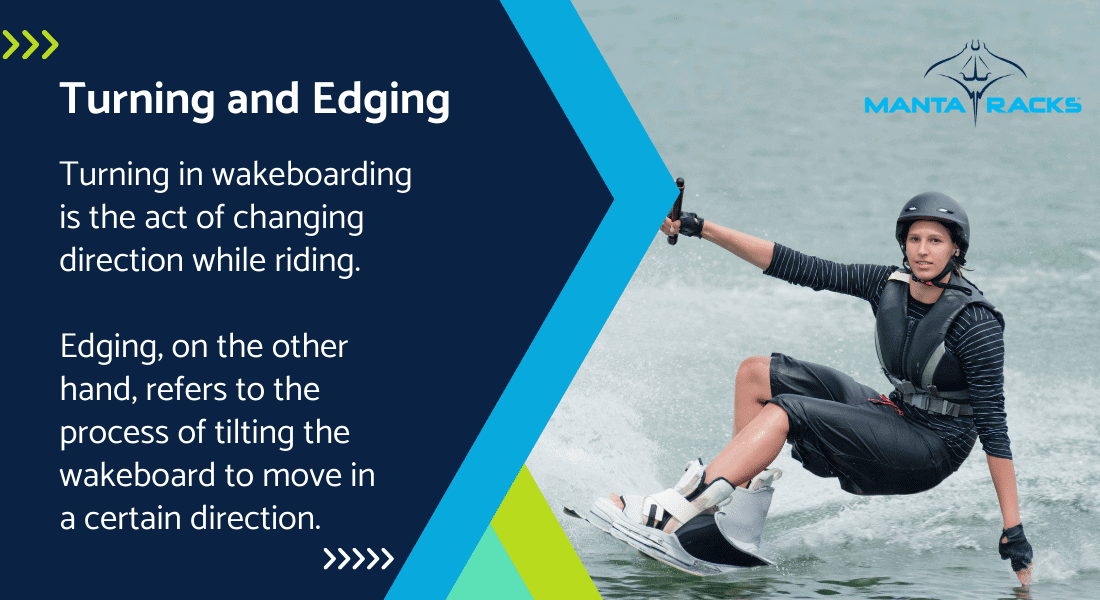
Progressing to More Advanced Tricks
Now that we’ve covered the fundamentals of wakeboarding for more advanced riders and beginners, it’s time to add some excitement by learning beginner tricks. These beginner moves will take your wakeboarding experience to a whole new level as you combine all the skills you have acquired.
We’ll start by looking at three suitable tricks for beginners: surface spins, jumping over the wake, and various grabs and slides. Although these maneuvers may require more skill and confidence, they’re exciting goals to work towards!
Surface Spins
A great starting point for beginner tricks on a wakeboard is performing surface spins. These involve using your hips to turn the board while keeping your elbows locked and knees bent. There are two types of surface spins you can try: the Surface 180 and Surface 360, both requiring hip movement to rotate the board.
To start with a Surface 180, bend your knees and use your hip rotation to make a smooth turn of 180 degrees while focusing on gripping onto and pulling the handle rather than just moving your feet or legs. For those looking for more challenge, try a full spin by executing similar techniques in a larger range – this is called a Surface Spin.
A 360 in wakeboarding is a trick where the rider makes a full spin, or rotation, on the horizontal axis while in the air, ending up facing the same direction they started. This requires a solid hip movement to complete the full spin, all while maintaining a firm grip on the handle for stability and control!
Jumping the Wake
Jumping the wake is an exhilarating maneuver that even beginners can tackle. This involves edging towards and leaping over the wake, landing in the flat water beyond. Not only does this basic jump provide a rush of adrenaline, but it also serves as a building block for more advanced tricks.
To successfully execute a wake jump:
- Maintain tension on your line while approaching the wake.
- Keep weight on your heels during takeoff.
- Turn back into the edge progressively before accelerating quickly using either toes or heels to dig in.
- Bend knees with chest up and straight back when ready to launch.
Don’t forget that practice makes perfect!
Grabs and Slides
Let’s discuss the exciting elements of grabs and slides in wakeboarding. These moves are essential for adding style and flair to your repertoire on the water. Grabs involve holding onto the edge of your board while flying through the air, while slides demonstrate balance, control, and creativity as you glide along a rail or obstacle.
For those new to wakeboarding tricks, two popular tricks include Tail Grabbing – where one pulls their knees up towards them in mid-air then grasps onto the back end of their board for an extra touch – And Butter Sliding which requires rotating at a 90-degree angle away from your initial direction. With practice comes proficiency in these techniques. Once perfected, they can elevate your skills giving off impressive style during rides.

Tips for Continuous Improvement
The world of wakeboarding offers an endless opportunity for learning and growth, with new tricks to master and skills to develop constantly. To continue improving in this exciting sport, it is important to regularly practice, seek guidance from experienced riders, and prioritize safety while having fun.
In the following sections, we’ll provide valuable tips for enhancing your wakeboarding abilities continuously. Whether you are a beginner looking to progress or an experienced rider aiming at perfecting your techniques, this advice will serve as an essential resource throughout your ongoing wakeboarding adventure.
Practicing Regularly
Consistent practice is essential for improvement in wakeboarding, just as it is in any other sport. Regularly hitting the water not only helps to increase strength and enhance technique but also boosts confidence and familiarity with both the board and the water.
In on-water practice, various off-water exercises can contribute positively towards enhancing performance in wakeboarding. These include crunches, planks, Russian twists, stretching activities such as yoga poses (e.g., downward dog), boat pose, or cat pose), trampoline workouts, and jumping rope sessions alongside utilizing cable parks and balance boards.
Learning from Experienced Riders
Gaining knowledge from those who have been in your shoes is invaluable. Experienced wakeboarders can offer valuable insights and guidance to help you navigate the learning curve of this sport. They can teach you how to master techniques, avoid common mistakes, and handle challenging conditions such as rough waters or strong winds.
Seasoned riders also serve as a source of inspiration for newcomers. Observing their skills on the water, whether it’s executing complicated tricks or effortlessly riding waves, can motivate you to keep practicing and advancing in the sport. Their achievements are living proof that with regular practice, dedication, and passion for wakeboarding one can reach great heights.
Staying Safe and Having Fun
It’s crucial to prioritize safety while wakeboarding. This should always be a top priority and involve:
- Make sure you have appropriate safety equipment on, such as a life jacket
- Practicing your swimming abilities beforehand
- Being respectful of others around you
- Staying hydrated throughout the day
- Understanding your capabilities and limitations
- Having someone designated to watch out for any potential hazards or issues (spotter)
- Knowing hand signals used in communication with the boat driver.
Also, keep in mind that wakeboarding is an exhilarating experience meant to be enjoyed. It’s about experiencing excitement during each ride, mastering new skills, and taking pride in the progress made over time. As long as one maintains safe practices on the water while enjoying their favorite tricks behind the boat, they can truly appreciate all aspects of this thrilling activity.
Final Thoughts
Wakeboarding is an exciting and demanding water activity that offers endless possibilities for advancement. To ensure a successful experience, get the necessary equipment such as a Manta Racks Wakeboard Rack, a wakeboard, a life jacket, a tow rope, and access to either a boat or cable park.
Whether you’re just starting on your journey in wakeboarding or seeking ways to enhance your skills, safety should always be prioritized while also enjoying the thrill of this sport and continuously pushing yourself with new tricks. By mastering the basics and continually improving upon them, you’ll be able to navigate through smooth waters like a pro!
Frequently Asked Questions
Is wakeboarding hard for beginners?
For novice wakeboarders, mastering the sport can be a challenge, especially standing up on the board. With consistent practice and perseverance (and proper techniques), this hurdle will become increasingly easy to overcome.
Don’t get discouraged and continue putting in effort as progress will eventually come.
How can I improve my wakeboarding?
To enhance your wakeboarding abilities, consider incorporating snowboarding into your routine as it activates similar muscles and engages the core. Utilizing balance boards and exercises can also help improve coordination while studying videos for wakeboarding tips can provide valuable insight.
Investing in better gear can make a difference in performance on the water. Practicing trampolining is another effective way to hone skills off of the wakeboard. Strengthening muscles used during wakeboarding, lifting weights, or working out regularly is recommended.
What’s the best trick for wakeboarding?
The surface spin, a 180° rotation on water, is a key trick for wakeboarding beginners. This maneuver is impressive. And it provides a strong foundation for future progress in the sport. It’s a crucial technique to master before attempting more advanced tricks, setting the stage for a successful beginner wakeboarding journey.
What’s the most crucial gear for a beginner wakeboarder?
For beginners in wakeboarding, two essential pieces of gear that should not be overlooked are a well-fitted life jacket and a reliable helmet. These items have the crucial role of providing safety and protection while out on the water. It is important to make sure both meet Coast Guard standards for optimal performance.
Did you enjoy this post? You might like these too:
- Wakeboard Storage: What’s the Best Rack For Boats?
- Protect Your Wakeboard & Discover How to Buy the Best Wakeboard
- The Ultimate Guide to the Best Places to Paddleboard in Florida
- 13 Exciting Boat Activities to Try Out Now
- Kayak Fishing 101: Tips for Beginners
- The Ultimate SUP Fishing Guide & Paddleboarding Basics & Fun & Basic SUP Strokes & Safety Tips & Equipment You Need to Carry SUP Boards
- 18+ Must-Have Boat Accessories – Don’t Leave Without Them!

